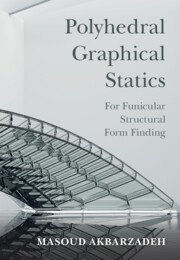Book contents
- Frontmatter
- Dedication
- Contents
- Contributors
- Foreword
- Foreword
- Preface
- Acknowledgments
- Introduction: A Brief History
- 1 Equilibrium of a Single Node
- 2 Equilibrium of a System of Forces
- 3 Compression-Only Form Finding
- 4 Articulated Compression-Only Forms
- 5 Systems with Combined Tension and Compression
- 6 Geometric Degrees of Freedom in Design of Form and Force Diagrams
- 7 Algebraic Formulation for Polyhedral Graphic Statics
- 8 Broader Applications of Polyhedral Graphic Statics
- References
- Index
6 - Geometric Degrees of Freedom in Design of Form and Force Diagrams
Published online by Cambridge University Press: 13 March 2025
- Frontmatter
- Dedication
- Contents
- Contributors
- Foreword
- Foreword
- Preface
- Acknowledgments
- Introduction: A Brief History
- 1 Equilibrium of a Single Node
- 2 Equilibrium of a System of Forces
- 3 Compression-Only Form Finding
- 4 Articulated Compression-Only Forms
- 5 Systems with Combined Tension and Compression
- 6 Geometric Degrees of Freedom in Design of Form and Force Diagrams
- 7 Algebraic Formulation for Polyhedral Graphic Statics
- 8 Broader Applications of Polyhedral Graphic Statics
- References
- Index
Summary
The chapter expanded on the definition, meaning, and application of Geometric Degrees of Freedom (GDoF) of the form and force diagrams in Polyhedral Graphic Statics. The number of independent edges in the network is the GDoF of a network of closed polygons/polyhedrons. An independent edge is an edge whose length can be independently chosen in constructing a network. These edges then determine the lengths of the rest of the edges in the network.
The geometric degree of freedom has different applications in the form and force diagrams. The GDoF of the force diagram in 2D and 3D allows exploring the static degrees of indeterminacies in the funicular form; the GDoF of the global force polygon/polyhedron corresponds to the external degrees of static indeterminacies in the funicular form.
Controlling the GDoF of a force diagram allows for removing reaction forces or applied loads in the boundary condition of a funicular form. This control can redistribute the internal forces in the structure’s members, e.g., from compression to tension, without changing the geometry of the funicular form and lead to exciting design options.
Like the force diagram, the form diagram also has geometric degrees of freedom. Using geometric degrees of freedom to manipulate the form diagram does change the form’s configuration but does not change the force magnitude and the equilibrium of forces in the system. Meanwhile, it opens the door to various funicular solutions ranging from compression-only to compression-and-tension combined systems.
Identifying the exact number of GDoF for both form and force diagrams in 3D is not a trivial task. It requires an algebraic formulation of the problem.
Keywords
- Type
- Chapter
- Information
- Polyhedral Graphical StaticsFor Funicular Structural Form Finding, pp. 304 - 358Publisher: Cambridge University PressPrint publication year: 2025

